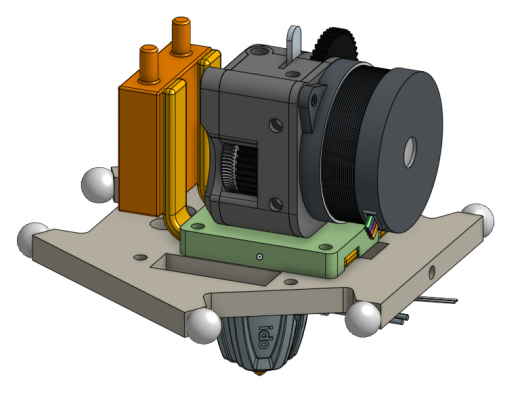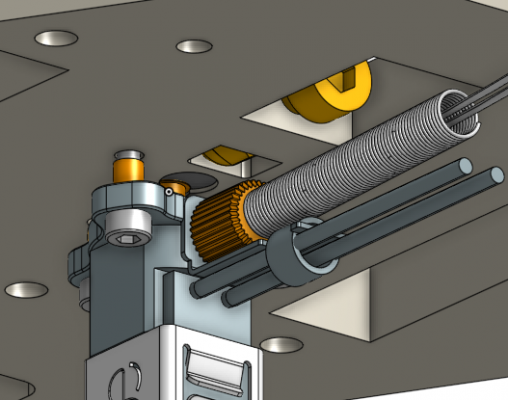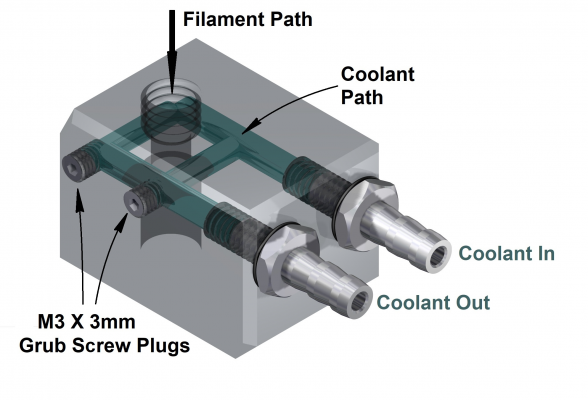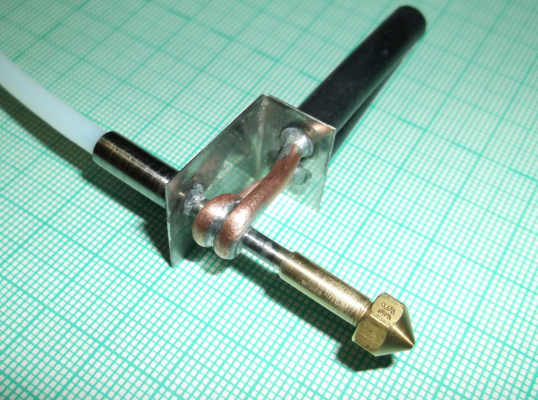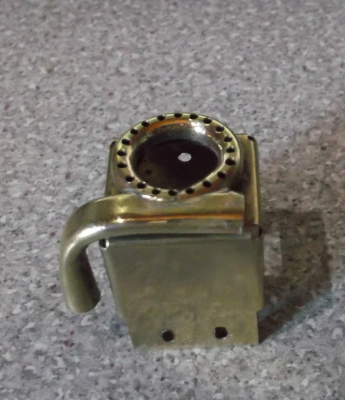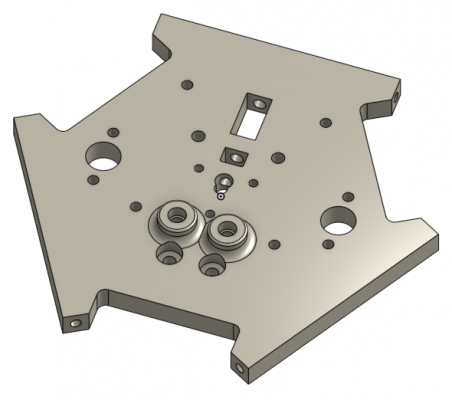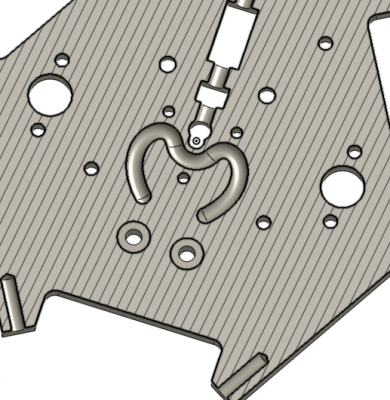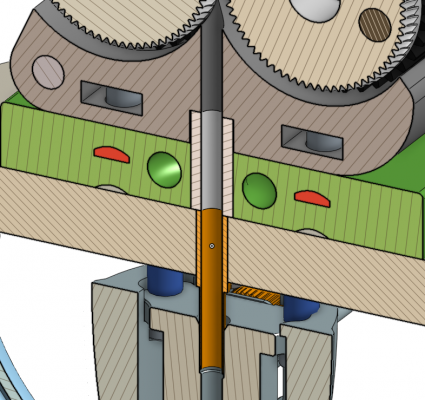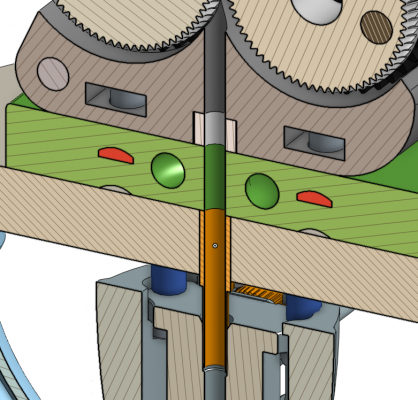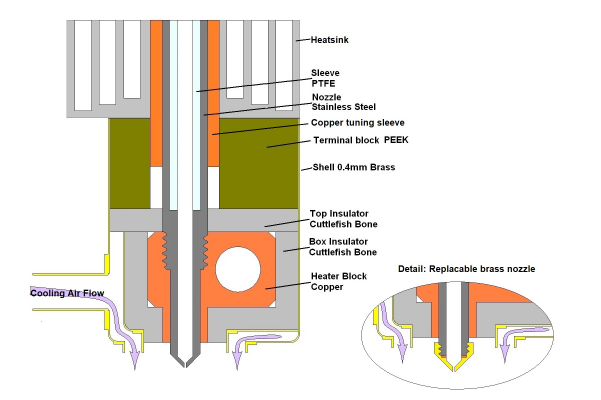FLSUN SR: direct-drive and water-cooling
Posted by fma
|
FLSUN SR: direct-drive and water-cooling November 16, 2023 03:18AM |
Registered: 12 years ago Posts: 300 |
Hi!
Last year, I replaced my big home-made CoreXY 3D printer with a used FLSUN SR. This is a nice printer, but I don't like Bowden extruders¹. So, I recently replaced the SR one with an Orbiter (using the original hotend).
As I would like to print special filaments, like ABS, ABS+glass fiber/carbon, or even PC/POM, I plan to make an enclosure, and use a better extruder and hotend (I chose a Bondtech LGX Lite, and a Phaetus Rapido 2 Plus HF). Like on my CoreXY, I would like to water cool the hotend. So, I'm designing a new custom effector (which will be CNC milled, probably by PCBWAY), and I would like to have your feedback on my design:
First, I plan to remove the Rapido heat sink, and screw the heater block directly onto the effector. The heat break pressing part will be integrated in the effector too.
Second, I plan to use Propper Printing's idea: heat pipes, but here, with a copper water block (soldered to the heat pipes). The top surface of the effector and the bottom surface of the part holding the extruder and pressing the heat pipes onto the effector will be polished, to get a good thermal contact.
I have no idea what power to dissipate in order to keep the heat break cool, and have the best thermal gradiant possible. But I think a water cooling system should be able to transfer much more heat than a air cooling system. At least, if well designed!
I first wanted to integrate the water cooling into the effector itself, but I didn't find a good way to do that (the problem is to manufacture the holes, due to the weird shape of the effector).
Any advice welcome!
Thanks,
PS: I'm not sure I will keep the original cooling fans, but rather use a berd-air pump, like I did on my CoreXY.
¹ I already did some tests in the past and found that Bowden extruders modify the structure of the plastic, leading to much more brittle parts. I think this is because of the pressure of the extruder gears on the filament, followed by a long time to rest before beeing melted... I would love to have the exact explanation.
Frédéric
Last year, I replaced my big home-made CoreXY 3D printer with a used FLSUN SR. This is a nice printer, but I don't like Bowden extruders¹. So, I recently replaced the SR one with an Orbiter (using the original hotend).
As I would like to print special filaments, like ABS, ABS+glass fiber/carbon, or even PC/POM, I plan to make an enclosure, and use a better extruder and hotend (I chose a Bondtech LGX Lite, and a Phaetus Rapido 2 Plus HF). Like on my CoreXY, I would like to water cool the hotend. So, I'm designing a new custom effector (which will be CNC milled, probably by PCBWAY), and I would like to have your feedback on my design:
First, I plan to remove the Rapido heat sink, and screw the heater block directly onto the effector. The heat break pressing part will be integrated in the effector too.
Second, I plan to use Propper Printing's idea: heat pipes, but here, with a copper water block (soldered to the heat pipes). The top surface of the effector and the bottom surface of the part holding the extruder and pressing the heat pipes onto the effector will be polished, to get a good thermal contact.
I have no idea what power to dissipate in order to keep the heat break cool, and have the best thermal gradiant possible. But I think a water cooling system should be able to transfer much more heat than a air cooling system. At least, if well designed!
I first wanted to integrate the water cooling into the effector itself, but I didn't find a good way to do that (the problem is to manufacture the holes, due to the weird shape of the effector).
Any advice welcome!
Thanks,
PS: I'm not sure I will keep the original cooling fans, but rather use a berd-air pump, like I did on my CoreXY.
¹ I already did some tests in the past and found that Bowden extruders modify the structure of the plastic, leading to much more brittle parts. I think this is because of the pressure of the extruder gears on the filament, followed by a long time to rest before beeing melted... I would love to have the exact explanation.
Frédéric
|
Re: FLSUN SR: direct-drive and water-cooling November 16, 2023 10:06AM |
Registered: 12 years ago Posts: 1,450 |
While very elegant, the heat transferred from the hot end doesn't justify heat pipes - which will just add mass, time and expense.
For evidence, I can vouch for the water-cooled cold-ends shown here:
A bit of testing at [reprap.org] also shows an even smaller working water-cooled cold-end from Zatsit
For evidence, I can vouch for the water-cooled cold-ends shown here:
A bit of testing at [reprap.org] also shows an even smaller working water-cooled cold-end from Zatsit
|
Re: FLSUN SR: direct-drive and water-cooling November 17, 2023 04:04AM |
Registered: 12 years ago Posts: 300 |
Thanks for you feedback!
About the pipes, I first wanted to use a fan, as Propper Printing did; do you think it would be enough in an enclosed setup? I may not need a water cooling system, after all...
BTW, I know the Zatsit design, and even ordered one! But I never got it, as the guy had to drop the entire project for health reasons.
Frédéric
About the pipes, I first wanted to use a fan, as Propper Printing did; do you think it would be enough in an enclosed setup? I may not need a water cooling system, after all...
BTW, I know the Zatsit design, and even ordered one! But I never got it, as the guy had to drop the entire project for health reasons.
Frédéric
|
Re: FLSUN SR: direct-drive and water-cooling November 17, 2023 06:36AM |
Registered: 12 years ago Posts: 1,450 |
The higher above room temperature you run your enclosure the worse air cooling becomes. I think water cooling is needed for anything above 40ºC.
You could form a copper water tube to fit exactly where you show your heat pipes. Thin-walled K&R copper or brass tube can be formed by filling it tightly with fine silver sand, crimping the ends, annealing to red heat then bending or hammering to shape. Example of bending and flattening here:
You could form a copper water tube to fit exactly where you show your heat pipes. Thin-walled K&R copper or brass tube can be formed by filling it tightly with fine silver sand, crimping the ends, annealing to red heat then bending or hammering to shape. Example of bending and flattening here:
|
Re: FLSUN SR: direct-drive and water-cooling November 17, 2023 08:46AM |
Registered: 12 years ago Posts: 300 |
|
Re: FLSUN SR: direct-drive and water-cooling November 20, 2023 04:59AM |
Registered: 12 years ago Posts: 300 |
|
Re: FLSUN SR: direct-drive and water-cooling November 21, 2023 05:27AM |
Registered: 12 years ago Posts: 1,450 |
If the body of the effector is metal then the water path you show should be good. I don't think a plastic 3D printer effector would be any good though - if that is what you mean by 3D printed.
In general, the thinner and lighter the stainless steel of the heat-break is the less cooling the cold-end has to do. Obviously, the heat -break has to mechanically support the hot-end so it can't be too thin. Having some form of insulation between the hot-end and cold-end to prevent convection and radiation from transferring heat helps as well - I found that cuttlefish bone was an astonishingly good high-temperature insulator if wrapped in Kapton tape.
Some early hot-ends did not have a cold-end at all and worked very well until they were tried on printers with Bowden feed. The necessity of retraction between moves transferred enough heat to gum things up. In general, Delta printers do need more cooing than others, but still not nearly as much as on many printers. If you are using direct drive then you can probably reduce the cooling again.
Mike
In general, the thinner and lighter the stainless steel of the heat-break is the less cooling the cold-end has to do. Obviously, the heat -break has to mechanically support the hot-end so it can't be too thin. Having some form of insulation between the hot-end and cold-end to prevent convection and radiation from transferring heat helps as well - I found that cuttlefish bone was an astonishingly good high-temperature insulator if wrapped in Kapton tape.
Some early hot-ends did not have a cold-end at all and worked very well until they were tried on printers with Bowden feed. The necessity of retraction between moves transferred enough heat to gum things up. In general, Delta printers do need more cooing than others, but still not nearly as much as on many printers. If you are using direct drive then you can probably reduce the cooling again.
Mike
|
Re: FLSUN SR: direct-drive and water-cooling November 21, 2023 10:21AM |
Registered: 12 years ago Posts: 300 |
Thanks for these advices!
I'm using a direct drive extruder, but my goal is to print high temperature materials, like ABS or Nylon, so I think I need a good cooling. For PLA, the effector alone may be enough.
BTW, yes, I plan to have the effector 3D printed in metal (aluminium), not in plastic
Frédéric
I'm using a direct drive extruder, but my goal is to print high temperature materials, like ABS or Nylon, so I think I need a good cooling. For PLA, the effector alone may be enough.
BTW, yes, I plan to have the effector 3D printed in metal (aluminium), not in plastic

Frédéric
|
Re: FLSUN SR: direct-drive and water-cooling November 23, 2023 08:29AM |
Registered: 12 years ago Posts: 300 |
Another question: in the separate cooling part version (which also better handles the extruder with 4 screws instead of 2), is it better to have the PTFE tube go through it, down to the heatbreak:
or to avoid PTFE in the cooling part:
The first solution has less friction, but the second solution allows the filament to be cooled up to the extruder...
Edited 1 time(s). Last edit at 11/23/2023 10:10AM by fma.
Frédéric
or to avoid PTFE in the cooling part:
The first solution has less friction, but the second solution allows the filament to be cooled up to the extruder...
Edited 1 time(s). Last edit at 11/23/2023 10:10AM by fma.
Frédéric
|
Re: FLSUN SR: direct-drive and water-cooling November 25, 2023 05:25AM |
Registered: 12 years ago Posts: 1,450 |
It is a difficult question to give a definitive answer to as too many variables come into where the best place for any PTFE is. The most commonly used solution is to have the PTFE end well before the cold end, giving an "all metal" path.
A low friction path is obviously the ideal, but the area where semi-molten plastic is being moved back and forth with retraction and with feed. The plastic can solidify and jam on any step (and there is always a step)
I made perhaps a dozen variations on my nozzles to try to get something that would work with ABS, PLA, and Nylon and found a workable compromise. The final solution had the PTFE a little below the bottom of the heatsink and the copper tuning slug about where it is shown in the drawing.
Having said that it works, I still have to disassemble the nozzle a couple of times a year to clean out plastic that has forced itself between the PTFE and the stainless steel of the feed tube.
Mike
A low friction path is obviously the ideal, but the area where semi-molten plastic is being moved back and forth with retraction and with feed. The plastic can solidify and jam on any step (and there is always a step)
I made perhaps a dozen variations on my nozzles to try to get something that would work with ABS, PLA, and Nylon and found a workable compromise. The final solution had the PTFE a little below the bottom of the heatsink and the copper tuning slug about where it is shown in the drawing.
Having said that it works, I still have to disassemble the nozzle a couple of times a year to clean out plastic that has forced itself between the PTFE and the stainless steel of the feed tube.
Mike
|
Re: FLSUN SR: direct-drive and water-cooling November 25, 2023 05:03PM |
Registered: 12 years ago Posts: 300 |
Thanks for sharing your design! Nice hotend! I like very much the integrated fan duct...
On my previous DIY printer, I used a FNU hotend, which was made in one part, nozzle + looong heat-break, so it couldn't clog at all.
[wiki.logre.eu]
[wiki.logre.eu]
I also designed an extruder using Bondtech double-gear, and both were working really great for more than 3 years, without any maintenance.
Anyway, for this new design, I think I will first try the version without PTFE, and enlarge the hole to add one if it does not work well. I received my Rapido hotend: I will open it to see how they deal with the heatbreak/heatsink joint...
Frédéric
On my previous DIY printer, I used a FNU hotend, which was made in one part, nozzle + looong heat-break, so it couldn't clog at all.
[wiki.logre.eu]
[wiki.logre.eu]
I also designed an extruder using Bondtech double-gear, and both were working really great for more than 3 years, without any maintenance.
Anyway, for this new design, I think I will first try the version without PTFE, and enlarge the hole to add one if it does not work well. I received my Rapido hotend: I will open it to see how they deal with the heatbreak/heatsink joint...
Frédéric
Sorry, only registered users may post in this forum.
